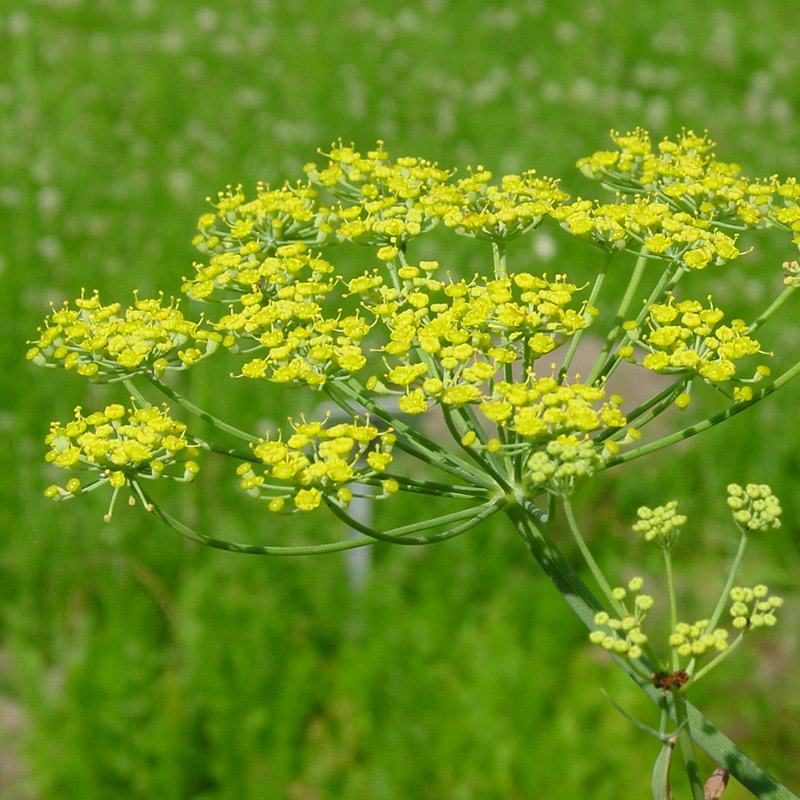Botanical name
(Bitter) Fennel - Foeniculum vulgare Mill. ssp. vulgare var. vulgare
Sweet Fennel – Foeniculum vulgare Mill. ssp. vulgare var. dulce (Mill.) Batt. & Trab.
Family
Apiaceae
Common name
Common fennel, Garden fennel, Wild fennel
Information about the plant
Common fennel (Foeniculum vulgare Mill.) is native to the Mediterranean region, where it is found as two subspecies. The subspecies piperitum (Pepper or Bulgarian fennel) grows wild on dry, rocky soils, while the subspecies vulgare (Garden fennel) is mostly cultivated throughout Europe and other temperate zones as a two year old crop, and is also found in the wild. Three variants of this have developed over time: var. vulgare, the bitter fennel, with its bitter-sweet and slightly pungent fruit; var. dulce, the sweet or Roman fennel with pleasantly sweet-tasting fruits; and var. azoricum, the vegetable or Florence fennel, with fleshy leaf sheaths at the base of the stem and popular as a vegetable. The Latin genus name Foeniculum comes from the Latin "fenum" (= hay), which is used here in the diminutive form. The blue-green, blueish frosted plant grows up to 120 cm and blooms in July/August with numerous small golden-yellow flowers, of which 12 to 25 are arranged in double-rayed umbels. The aromatic leaves are scented with conspicuous leaf sheaths in a pithy stem. They are 3 to 4 times pinnate with very narrow, almost thread-like leaves. When ripe, they are greenish-brown fruits, 3 to 12 mm long with 5 light, angular protruding ribs. Like all Apiaceae, it has "double achenes", which easily disintegrate even before they come apart into the two fruits (achenes). Sweet fennel is very similar to bitter fennel; it grows up to 2 m high and its fruits are lighter in colour.
Medicinally used parts of plants (herbal drug)
The ripe fruits of both fennel varieties (bitter fennel - Foeniculi amari fructus; sweet fennel - Foeniculi dulcis fructus) are used. The ripe fruit, with its typical smell of fennel, which is clearly notable when rubbed, is caused by the essential oil contained in the fruit. The commercially available drug is imported from China, Egypt, Bulgaria, Hungary, and Romania.
Constituents of the herbal drug
Fennel fruits contain an essential oil ("Bitter fennel oil") with sweet-tasting trans-anethole (main component) and the bitter fenchone that gives bitter fennel its slightly bitter taste. The essential oil of sweet fennel (var. dulce) contains significantly less fenchone, so the flavour of the fruit is dominated by the sweet trans-anethole. The essential oil of both fennel varieties contains estragole (see “Notes”). The fennel fruit also contains fatty oil.
Quality of the drug
The quality of the following drugs or drug preparations is specified in the European Pharmacopoeia (Ph. Eur.):
- Bitter fennel (Foeniculi amari fructus)
- Sweet fennel (Foeniculi dulcis fructus)
- Bitter fennel oil (Foeniculi amari fructus aetheroleum)
- Bitter fennel herb oil (Foeniculi amari herbae aetheroleum)
Medical applications
Recognised medical use
The HMPC has classified fennel and fennel oil as traditional herbal medicinal products (see "traditional use"). The monograph on bitter fennel oil was withdrawn (see below).
ESCOP: Bitter/sweet fennel and bitter fennel oil: for dyspeptic complaints such as mild, spasmodic gastrointestinal complaints, flatulence, and bloating; catarrh of the upper respiratory tract; bitter fennel can also be used to relieve menstrual cramps. These areas of application are based on the findings of long-standing use in humans.
Traditional use
The HMPC has classified fennel as a traditional herbal medicine (Article 16a of Directive 2001/83/EC). Based upon long-standing use, fennel can be used for symptomatic treatment of minor spasm associated with menstrual periods and as an expectorant in cough associated with cold.
Important information on bitter fennel oil: Due to new findings on the genotoxicity and carcinogenicity of estragole, a component of the essential oil of bitter fennel , the HMPC has withdrawn its monograph on bitter fennel oil and thus made it clear that bitter fennel oil can no longer be considered a traditional medicinal product within the meaning of the HMPC for safety reasons.
Herbal drug preparations in finished dosage forms
- Finely cut fennel fruit for teas, in tea bags
- Alcoholic extracts (tincture) in drops
- Dried extracts in tablets
Tasty preparations such as fennel syrup and fennel honey can be used for colds, especially with children.
Dosage
Finished medicinal products: see patient information leaflet.
Tea infusion: Adults and adolescents: drink 1 cup of fennel tea warm 3 times a day (daily dose 4.5 g fennel) (also in mixtures with other drugs as gastrointestinal tea; cough and bronchial tea). Children (4 to 12 years): 1 cup 3 times a day (daily dose 3 g); see also “Notes”.
Preparation of a tea
Pour ¼ L of hot (not boiling!) water over 1 heaped teaspoon (1.5 g) of freshly chopped fennel fruits, let it stand for 15 minutes, and strain. To enhance the effectiveness, fennel fruits should be crushed or coarsely powdered before the tea is prepared.
Notes
Adults and adolescents may use fennel tea for a maximum of 2 weeks; children between 4 and 12 years of age for a maximum of 1 week, whereby the daily estragole intake must not exceed 1.0 µg/kg body weight. Children under 4 years of age should not use fennel tea. During pregnancy and breastfeeding, the daily estragole intake must not exceed 1.0 mg. Fennel preparations must be avoided in cases where there is an existing allergy to Apiaceae (fennel, caraway, celery, cilantro or dill) or to anethole. Important information on bitter fennel oil: see "Traditional use"!
Side effects
None known.
Interactions
None known.
References
Herbal drug monographs
HMPC (2007, 2022, 2024), ESCOP (2019), WHO (Vol. 3, NIS)
Further literature
Commentary on the European Pharmacopoeia (Bitter fennel, Nr. 0824; Sweet fennel, Nr. 0825; Bitter fennel oil, Nr. 1826; Bitter fennel herb oil, Nr. 2380)


